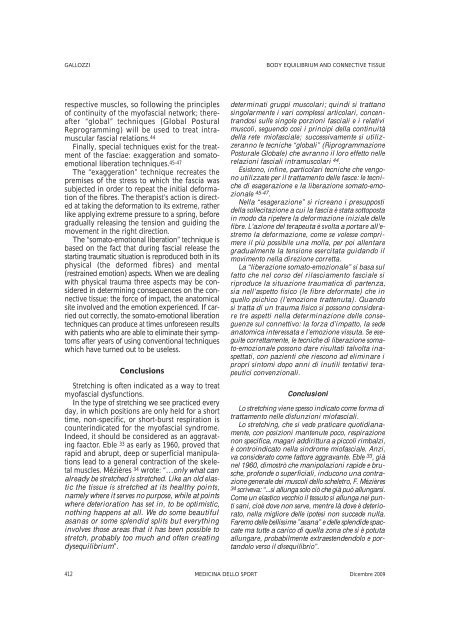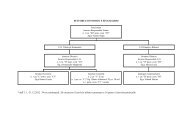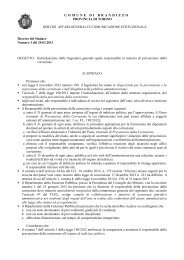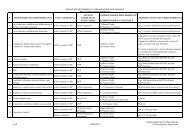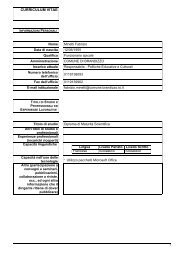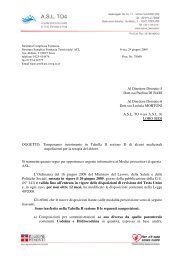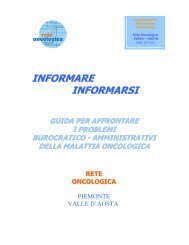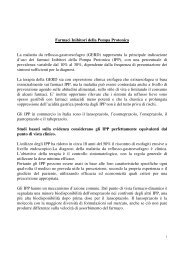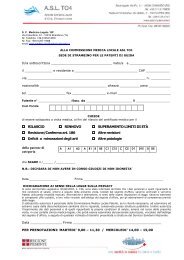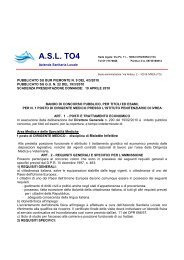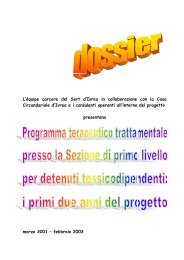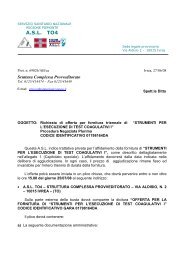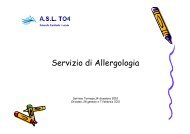Articolo sulla casistica delle non idoneità allo sport agonistico in ...
Articolo sulla casistica delle non idoneità allo sport agonistico in ...
Articolo sulla casistica delle non idoneità allo sport agonistico in ...
Create successful ePaper yourself
Turn your PDF publications into a flip-book with our unique Google optimized e-Paper software.
GALLOZZI BODY EQUILIBRIUM AND CONNECTIVE TISSUE<br />
respective muscles, so follow<strong>in</strong>g the pr<strong>in</strong>ciples<br />
of cont<strong>in</strong>uity of the myofascial network; thereafter<br />
“global” techniques (Global Postural<br />
Reprogramm<strong>in</strong>g) will be used to treat <strong>in</strong>tramuscular<br />
fascial relations. 44<br />
F<strong>in</strong>ally, special techniques exist for the treatment<br />
of the fasciae: exaggeration and somatoemotional<br />
liberation techniques. 45-47<br />
The “exaggeration” technique recreates the<br />
premises of the stress to which the fascia was<br />
subjected <strong>in</strong> order to repeat the <strong>in</strong>itial deformation<br />
of the fibres. The therapist’s action is directed<br />
at tak<strong>in</strong>g the deformation to its extreme, rather<br />
like apply<strong>in</strong>g extreme pressure to a spr<strong>in</strong>g, before<br />
gradually releas<strong>in</strong>g the tension and guid<strong>in</strong>g the<br />
movement <strong>in</strong> the right direction.<br />
The “somato-emotional liberation” technique is<br />
based on the fact that dur<strong>in</strong>g fascial release the<br />
start<strong>in</strong>g traumatic situation is reproduced both <strong>in</strong> its<br />
physical (the deformed fibres) and mental<br />
(restra<strong>in</strong>ed emotion) aspects. When we are deal<strong>in</strong>g<br />
with physical trauma three aspects may be considered<br />
<strong>in</strong> determ<strong>in</strong><strong>in</strong>g consequences on the connective<br />
tissue: the force of impact, the anatomical<br />
site <strong>in</strong>volved and the emotion experienced. If carried<br />
out correctly, the somato-emotional liberation<br />
techniques can produce at times unforeseen results<br />
with patients who are able to elim<strong>in</strong>ate their symptoms<br />
after years of us<strong>in</strong>g conventional techniques<br />
which have turned out to be useless.<br />
Conclusions<br />
Stretch<strong>in</strong>g is often <strong>in</strong>dicated as a way to treat<br />
myofascial dysfunctions.<br />
In the type of stretch<strong>in</strong>g we see practiced every<br />
day, <strong>in</strong> which positions are only held for a short<br />
time, <strong>non</strong>-specific, or short-burst respiration is<br />
counter<strong>in</strong>dicated for the myofascial syndrome.<br />
Indeed, it should be considered as an aggravat<strong>in</strong>g<br />
faactor. Eble 33 as early as 1960, proved that<br />
rapid and abrupt, deep or superficial manipulations<br />
lead to a general contraction of the skeletal<br />
muscles. Mézières 34 wrote: “…only what can<br />
already be stretched is stretched. Like an old elastic<br />
the tissue is stretched at its healthy po<strong>in</strong>ts,<br />
namely where it serves no purpose, while at po<strong>in</strong>ts<br />
where deterioration has set <strong>in</strong>, to be optimistic,<br />
noth<strong>in</strong>g happens at all. We do some beautiful<br />
asanas or some splendid splits but everyth<strong>in</strong>g<br />
<strong>in</strong>volves those areas that it has been possible to<br />
stretch, probably too much and often creat<strong>in</strong>g<br />
dysequilibrium”.<br />
determ<strong>in</strong>ati gruppi muscolari; qu<strong>in</strong>di si trattano<br />
s<strong>in</strong>golarmente i vari complessi articolari, concentrandosi<br />
sulle s<strong>in</strong>gole porzioni fasciali e i relativi<br />
muscoli, seguendo così i pr<strong>in</strong>cipi della cont<strong>in</strong>uità<br />
della rete miofasciale; successivamente si utilizzeranno<br />
le tecniche “globali” (Riprogrammazione<br />
Posturale Globale) che avranno il loro effetto nelle<br />
relazioni fasciali <strong>in</strong>tramuscolari 44.<br />
Esistono, <strong>in</strong>f<strong>in</strong>e, particolari tecniche che vengono<br />
utilizzate per il trattamento <strong>delle</strong> fasce: le tecniche<br />
di esagerazione e la liberazione somato-emozionale<br />
45-47.<br />
Nella “esagerazione” si ricreano i presupposti<br />
della sollecitazione a cui la fascia è stata sottoposta<br />
<strong>in</strong> modo da ripetere la deformazione <strong>in</strong>iziale <strong>delle</strong><br />
fibre. L’azione del terapeuta è svolta a portare all’estremo<br />
la deformazione, come se volesse comprimere<br />
il più possibile una molla, per poi allentare<br />
gradualmente la tensione esercitata guidando il<br />
movimento nella direzione corretta.<br />
La “liberazione somato-emozionale” si basa sul<br />
fatto che nel corso del rilasciamento fasciale si<br />
riproduce la situazione traumatica di partenza,<br />
sia nell’aspetto fisico (le fibre deformate) che <strong>in</strong><br />
quello psichico (l’emozione trattenuta). Quando<br />
si tratta di un trauma fisico si possono considerare<br />
tre aspetti nella determ<strong>in</strong>azione <strong>delle</strong> conseguenze<br />
sul connettivo: la forza d’impatto, la sede<br />
anatomica <strong>in</strong>teressata e l’emozione vissuta. Se eseguite<br />
correttamente, le tecniche di liberazione somato-emozionale<br />
possono dare risultati talvolta <strong>in</strong>aspettati,<br />
con pazienti che riescono ad elim<strong>in</strong>are i<br />
propri s<strong>in</strong>tomi dopo anni di <strong>in</strong>utili tentativi terapeutici<br />
convenzionali.<br />
Conclusioni<br />
Lo stretch<strong>in</strong>g viene spesso <strong>in</strong>dicato come forma di<br />
trattamento nelle disfunzioni miofasciali.<br />
Lo stretch<strong>in</strong>g, che si vede praticare quotidianamente,<br />
con posizioni mantenute poco, respirazione<br />
<strong>non</strong> specifica, magari addirittura a piccoli rimbalzi,<br />
è contro<strong>in</strong>dicato nella s<strong>in</strong>drome miofasciale. Anzi,<br />
va considerato come fattore aggravante. Eble 33, già<br />
nel 1960, dimostrò che manipolazioni rapide e brusche,<br />
profonde o superficiali, <strong>in</strong>ducono una contrazione<br />
generale dei muscoli dello scheletro, F. Mézières<br />
34 scriveva: “...si allunga solo ciò che già può allungarsi.<br />
Come un elastico vecchio il tessuto si allunga nei punti<br />
sani, cioè dove <strong>non</strong> serve, mentre là dove è deteriorato,<br />
nella migliore <strong>delle</strong> ipotesi <strong>non</strong> succede nulla.<br />
Faremo <strong>delle</strong> bellissime ”asana” e <strong>delle</strong> splendide spaccate<br />
ma tutte a carico di quella zona che si è potuta<br />
allungare, probabilmente extraestendendolo e portandolo<br />
verso il disequilibrio”.<br />
412 MEDICINA DELLO SPORT Dicembre 2009


